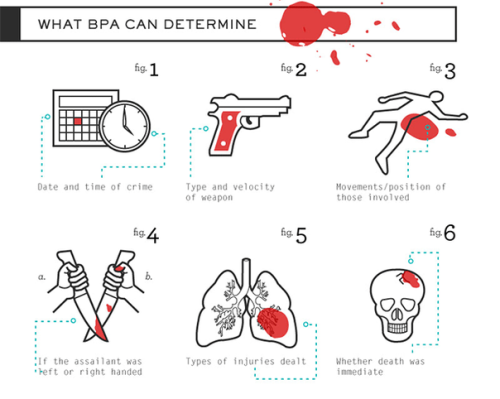murder-and-lee:
Bloodstain pattern analysis (BPA) is one of...

Bloodstain pattern analysis (BPA) is one of several forensic science specialities that can help determine what exactly came to pass on a scene of a violent crime. Technologies for it are evolving constantly, which leads to a higher degree of accuracy than in the past.
Eduard Piotrowski published a paper entitled “on the formation, form, direction, and spreading of blood stains resulting in blunt trauma at the head” in 1895. The various publications that followed did not lead to a systematic analysis the way we know today. Herbert Leon MacDonell advanced the research that eventually culminated in the 1971 publishing of “Flight Characterisics and Stain Patterns of Human Blood”. He went on to present the first formal training course for bloodstain pattern analysis.
Crime scene investigator Sherry Gutierrez put forth some general principles for the analysis of gunshot wounds in particular that roughly indicate what can be deduced from those. These are as follows:
The amount of forward spatter (away from the shooter) is greater than the back spatter (towards the shooter).
The velocity of the forward spatter is greater than the velocity of the back spatter.
Both forward and back spatter have a lower velocity than the bullet. (The relationship of the velocities from high to low can therefore be visualised as bullet –> forward spatter –> back spatter.)
Both forward and back spatter form a “cone” of mist.
The density of the fluid droplets from an impact to a fluid-containing structure decreases as the distance from the bullet impact increases.
High velocity wounds to bone may cause bone to go both forward and backward alongside the spatter.
The bullet exits in the direction opposite of the shooter.Forward spatter usually travels farther than the back spatter in the same incident. It also holds a larger volume of blood that expresses as individual stains than the back spatter does. Targets may move with the direction of the projectile upon the moment of impact, so (for example) someone who was shot in the back may move forward. Similarly, if the target is located in a moving vehicle the wind and other circumstances may affect the forward and back spatter to a degree.
Bloodstain pattern analysis can also be made visual by documenting bloodstains at the scene of the crime and measuring the angles of impact that can lead every trajctory back to an ‘origin point’. Nowadays, computer programs are used to visualise these calculations further and create a 3D-model of the circumstances of the crime. An older method is called “stringing” and consists of attaching a coloured string to the point of impact and running it to the termination point (like the wall or floor). The convergences and crossing points of these strings can then be used for crime scene reconstructions.



